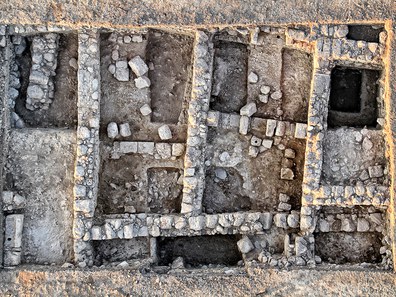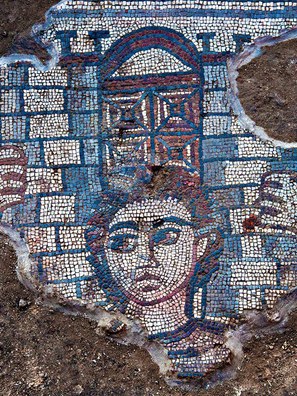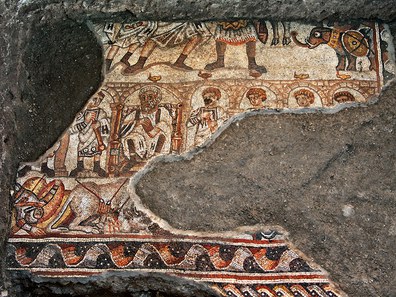Thanks to a Dumbarton Oaks project grant, the 2013 excavation season at Huqoq was highly successful, including the discovery of unique mosaics in the late antique (fifth-century) synagogue. The following summary highlights the discoveries in the ancient village and the synagogue.
Area 2000: The Ancient Village

There are no signs of destruction in Area 2000. Instead, the units were abandoned and gradually collapsed, as indicated by a thin layer of dirt that accumulated on top of the floors, which was buried under a build-up of stone collapse mixed with dirt. The accumulation on top of the floors seems to include the collapse of the roof (there is no evidence of a second story), as indicated by the presence of artifacts including grinding stones and a roof roller. After the roof collapsed, the walls gradually tumbled down.
The coins and pottery suggest that these units were occupied for approximately one century. The latest datable artifacts found under the floors and in the foundations of the walls provide an early fifth-century terminus post quem for the construction of these rooms. The latest pottery and coins found in the layers of fill and collapse above the floors date the final phase of occupation and abandonment to the first half of the sixth century.
Area 3000: The Synagogue
In 2011, excavations uncovered a small section of the late antique synagogue’s east wall, which is constructed of large, well-cut, smooth ashlar blocks of limestone. In 2012–13, additional squares were opened to the north and south, revealing the continuation of the synagogue’s east wall, including its southeast corner and part of the south façade.
Excavations in all of these squares have yielded the following stratigraphic sequence:
- In the twentieth century, this area was occupied by architectural remains, apparently belonging to village houses.
- In the nineteenth to early twentieth centuries, this was an open area with a series of tabuns surrounding the cistern, suggesting that this was a courtyard used for food preparation.
- In the Crusader-Mamluk period (twelfth–thirteenth centuries), a monumental public building with a cobble and plaster floor originally paved with mosaics was constructed above the Late Roman synagogue. It reused the Late Roman synagogue’s east wall and was lined by a bench made of reused blocks from the synagogue.
- Below the floor of the Crusader-Mamluk building is a 0.60–0.70 m-thick fill consisting of deliberately dumped layers of yellow and brown soil and yellow building chips, which was deposited directly on top of the mosaic floor of the Late Roman synagogue.
It is unclear whether there is a gap in occupation between the Crusader-Mamluk period and the nineteenth century. When the synagogue went out of use also has yet to be determined. The following description begins with the Crusader-Mamluk building and proceeds to the synagogue.
The Crusader-Mamluk Building
The Crusader-Mamluk building was first encountered in 2012, below a hard plaster and cobble surface of the nineteenth and twentieth centuries on which thirty-two lead musket balls were piled. The plaster and cobble surface ran up to and overlay the top of the synagogue’s east wall.
Approximately 0.20–0.30 m below the modern plaster and cobble surface, a cobble and plaster floor of the Crusader-Mamluk period was found. This floor is made of triangular basalt cobbles set in a thick bedding of plaster, pebbles, and crushed lime. A bench made of reused ashlars from the synagogue, which runs along the inside of the synagogue’s east wall, sits directly on top of this floor.
In 2013, the continuation of the synagogue’s east wall and the Crusader-Mamluk cobble and plaster floor with the bench was discovered in squares to the north and south. One of the stones in the uppermost (preserved) course of the synagogue’s east wall was recut as a 2 m-wide threshold block in the medieval period, apparently providing the main entry into the building at that time. The cobble and plaster floor runs up to this threshold block. Immediately inside and abutting the bench, a small patch of white mosaic decorated with a colored triangle or diamond pattern was preserved on the cobblestone floor. Perhaps this is the synagogue with a mosaic floor that Ishtori Haparchi reported seeing at Yakuk (Huqoq) in the early fourteenth century, although no archaeological evidence has been discovered yet indicating the building’s function. In this case, it would be the first synagogue constructed during the Crusader-Mamluk period ever discovered in Palestine. This piece of floor was left in situ because of the importance of a probable Crusader-Mamluk mosaic, while excavations in the rest of the square continued below.
The Synagogue
The synagogue’s northern extent is not yet known, as its east wall continues beyond the excavated squares. In 2013, the synagogue’s floor was reached in two squares: one to the south of the square with the scene of Samson and the foxes, which was found in 2012, and one to the north of that square. In addition, a square farther to the south revealed the synagogue’s southeast corner with a small part of the south façade. The area outside the south façade was heavily pitted, apparently due to the extensive robbing out of the walls.
Only one or two courses of the synagogue’s east wall are preserved above the level of the foundations. A thick layer of plain white plaster still adheres to the inner face of the wall. Below the Crusader-Mamluk floor was a deep fill of alternating layers of dark brown soil and yellow building chips containing large numbers of tesserae, some still adhering to chunks of bedding, small pieces of painted plaster, and coins. Rather than accumulating gradually over the course of time, this fill appears to have been dumped deliberately on top of the synagogue floor all at once, in connection with the laying of the cobble and plaster floor. Most of the pottery from this fill is Late Roman and Byzantine (fourth to sixth centuries), with a small number of Islamic and Crusader/Mamluk potsherds.
Excavations inside the southeast corner of the synagogue (to the south of the square with Samson and the foxes) brought to light a platform built of large ashlar blocks abutting the synagogue’s south wall, which apparently was a bema. Two rows of ashlars are preserved, and a third row on the north side had been robbed out, as indicated by impressions visible in the bedding. Just north of this platform, a rubble collapse was found on top of the mosaic floor. The collapse contained a large number of cut building stones and architectural fragments, an iron nail, chunks of burnt plaster, and ash which had charred the mosaic floor underneath. As the rubble and burning are limited to this area of the synagogue’s east aisle, we believe they are associated with the destruction and robbing out of the bema rather than the collapse of the roof.

Portions of a mosaic floor were discovered under the layers of fill and collapse, laid in a hard plaster bedding that was intact and ran up to the synagogue’s east wall. Three main sections of the mosaic survive. Alongside the synagogue’s east wall is a white border with a guilloche pattern. The guilloche pattern turns a corner just in front of the bema, where the mosaic ends, indicating that the mosaic and bema are contemporary. The guilloche pattern frames a large scene in the middle of the floor showing Samson carrying the gate of Gaza on his shoulders (as related in Judges 16:1-3). Samson is depicted as a giant with his hands wrapped around the sides of the gate. Another patch of mosaic below (to the west) preserves Samson’s red and blue belt, white tunic, and red cloak. In the northwest corner of the square (continuing into the baulks) is a third patch of mosaic showing a man with a horse, presumably a Philistine. Above them, the boot of another male figure and the hoofs of a horse are preserved. Samson is oriented with his head to the east, like the scene of Samson with the foxes discovered in 2012.

In the northernmost square excavated so far (north of the square with Samson and the foxes), large portions of mosaics were found. They are oriented to the west and are cut by a later pit in the southeast part of the square, just inside the Crusader-Mamluk threshold. A small patch of mosaic in the northwest corner of the square contains unidentified linear motifs that might represent parts of building. A large section of mosaic is preserved in the southwest and central parts of the square. It is divided into three horizontal (north-south) registers, one above the other, each containing figured scenes. Beginning on the left, the top register shows three men clothed in tunics and mantles marked with gammata or gammadia (here the Greek letter eta [Η]) moving towards a dark-skinned soldier standing in the center. The forelegs of an animal with cloven hoofs are visible to the right of the soldier. Farther to the right stands an elephant with a decorated collar or harness and shields tied to his sides. His trunk is raised and his eye is large and prominent. Part of another elephant is visible above (behind) the first elephant.
The register below this shows an arcade with lighted oil lamps above the arches. Each arch frames a single figure: young men grasping sheathed swords arranged around a large seated elderly man holding a scroll. Although all of these figures wear tunics and mantles with gammata, they are differentiated by details of their hairstyles. The register below this shows a bull pierced by spears, with blood gushing from his wounds, and a fallen and bleeding soldier grasping a shield. The three registers are encircled by a delicate wavy ribbon pattern. This mosaic differs in style, quality, and content from the Samson scenes. Its meaning is obscure, as it has no parallels in other ancient synagogues and is only partially exposed. The upper register might depict a triumphal parade, in which case the shields tied to the elephants are the spoils of war. Elephants are not mentioned in the Hebrew Bible, but they occur in 1-4 Maccabees, raising the possibility that these scenes are connected with stories about the Maccabees. In this case, it would be the first time scenes from an apocryphal book have been discovered decorating an ancient synagogue.
In addition to a season report that will be published in Hadashot Arkheologiyot, we are preparing a preliminary report on the 2011–2013 seasons for the Journal of Roman Archaeology. In 2014, excavations will continue in the ancient village and the synagogue, with more squares being opened in both areas to expose more of the dwelling units and the synagogue building.